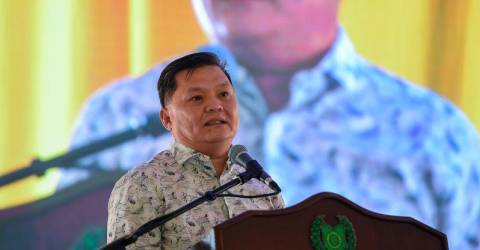ADVERTISE HERE

People boarding the ART smart tram on the Kuching-Samarahan Expressway. – Photo by Roystein Emmor
KUCHING (Dec 7): Sarawak’s pursuit for a sustainable solution to its escalating traffic challenges has taken a promising turn with the advent of the Autonomous Rapid Transit (ART) system.
This was voiced out by the local community leaders interviewed by The Borneo Post after a special ride on the ART smart tram along the Kuching-Samarahan Expressway today.
Sarawak Premier’s political secretary Kho Teck Wan said the ART system has the potential as a beacon of hope in alleviating traffic congestion.
“In the long run, this would perhaps replace some vehicles and reduce traffic congestion,” she said after her third ride on the ART smart tram here today.
She emphasised three pivotal advantages that position the ART system as a potential solution.
“They actually had a dedicated route just for this ART, so they would not impact any other vehicles that are traveling in the same direction.
“With sensors, when they go through the traffic light, when the ART is coming, the traffic light will turn green for the ART, technically being faster than the rest of the traffic.
“This is the first hydrogen-powered ART outside of China, and we are the only one here in Malaysia because of our reputation in researching and producing hydrogen. We save the environment as well,” she said.

Kho Teck Wan – Photo by Roystein Emmor
However, Kho acknowledged the need to address the feeder bus systems to become more seamless to ensure the overall success of the ART project.
Kampung Rantau Panjang Batu Kawa village head Putit Omar also voiced similar optimism about the ART system.
“It’s really good considering the current traffic situation, everywhere is congested, and with the presence of the ART, it can alleviate the congestion,” he said after his first ride.
Putit emphasised the ART system’s potential to save time and enhance safety for those commuting along its route, including in Samarahan.
He noted among features of the ART smart tram in which he found beneficial is the spacious interior, providing comfort even for standing passengers.

Putit Omar – Photo by Roystein Emmor
“My suggestion for improvement would be to enhance the comfort further, as well as add more lanes for the ART, for example to places like Batu Kawa, known for traffic jams. That would be great,” he said.
Meanwhile, Hui Sing community leader Kapitan Tan Kun Gee expressed hope that the ART system would help alleviate the recent surge in traffic jams.
“I think Sarawak is doing a good job because now, for the past 10 to 20 years, actually, we don’t have much traffic in Kuching, so seldom traffic jams.
“But now, we are going to have a lot of traffic jams, so probably this ART will help to reduce the traffic jam,” he said.

Kapitan Tan Kun Gee – Photo by Roystein Emmor
While foreseeing potential benefits for the public, Tan raised concerns about possible charges and suggested considerations for age-related concessions.
He also addressed specific concerns about the ART system’s approach to flyovers, emphasising the need for clarity on whether the system would utilise overpasses or underpasses.
“My question is that when they reach traffic light or roundabout or flyover, what will happen?
“I haven’t got my answer yet when you reach a flyover because over here (Samarahan), we don’t have a flyover, but when we go to Kuching like BDC area where there is a flyover, are they going to do their own track using the flyover or will they be doing it under,” he said.

Sarawak Metro stakeholders and guests experience the ride on the ART smart tram along the Kuching-Samarahan Expressway today. – Photo by Roystein Emmor
Apart from the community leaders, Sarawak Metro had also invited other stakeholders as well as members of the media for today’s proof-of-concept (POC) exercise to have a feel of riding on the ART smart tram.
The POC exercise will end this Dec 15.

 1 year ago
200
1 year ago
200



 English (US) ·
English (US) ·